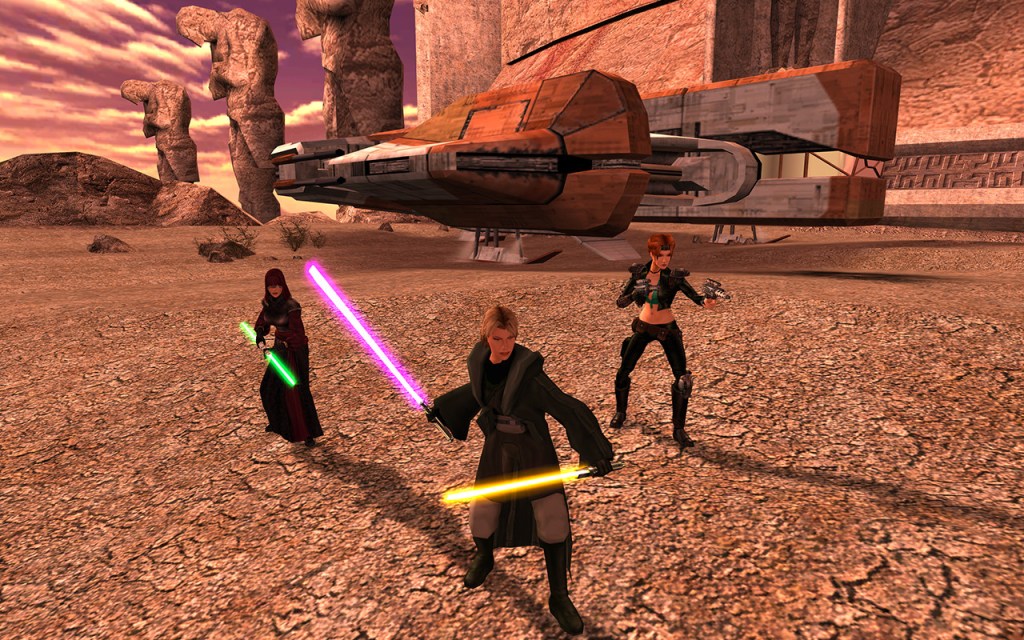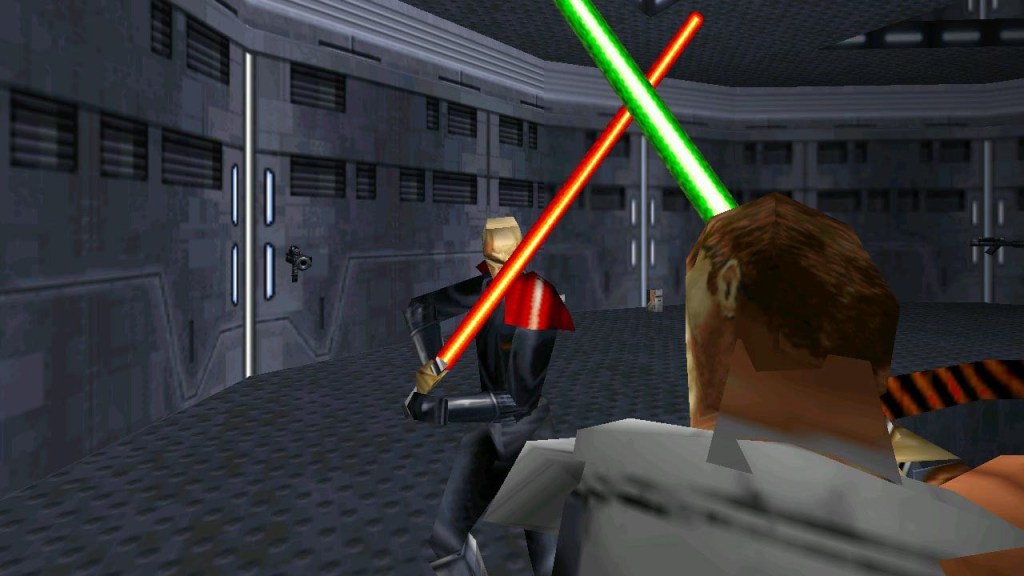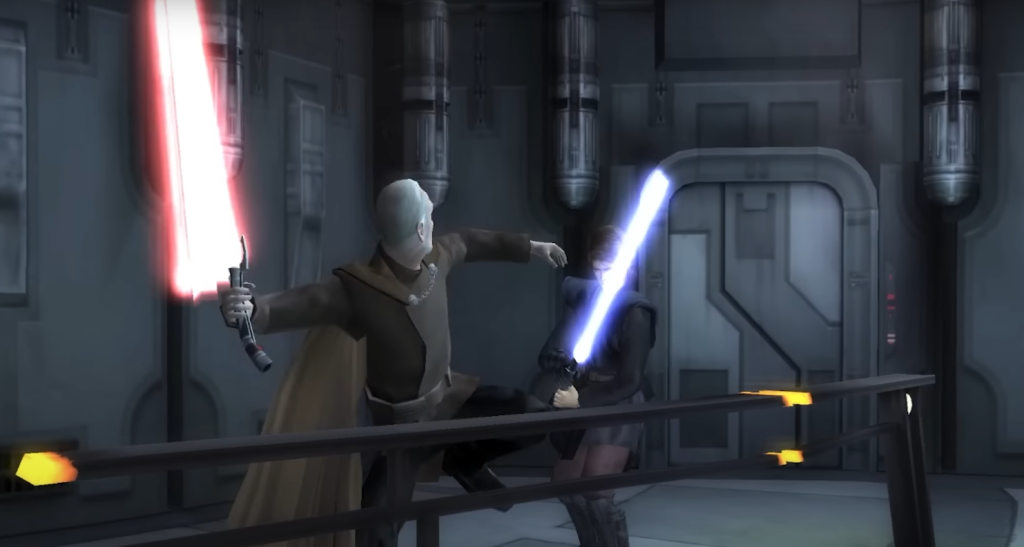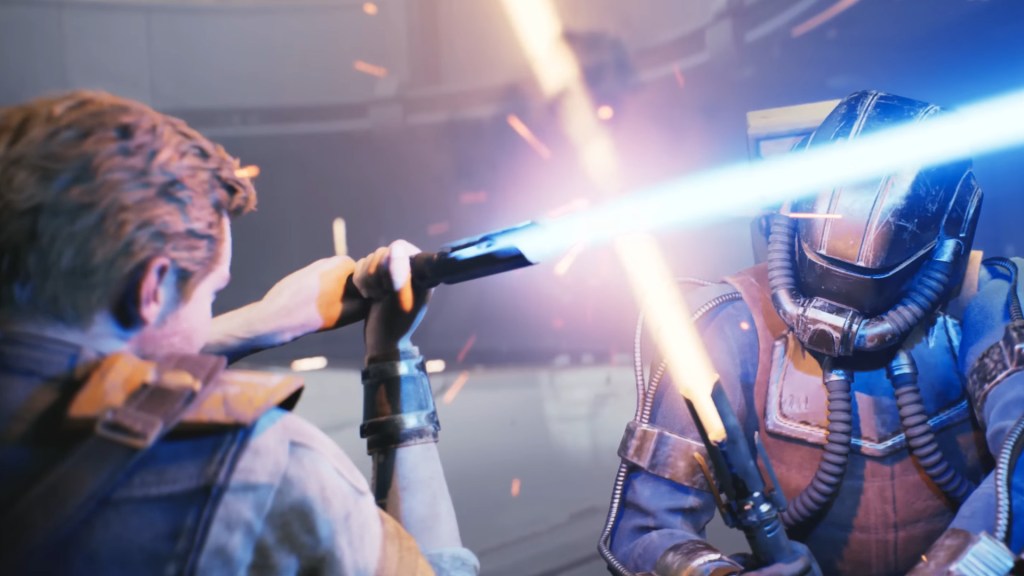The Star Wars Games That Revolutionized Lightsaber Combat
The Star Wars games that let us live the dream of swinging a lightsaber have come a long way over the last 40 years.

The launch of the Disney+ streaming series The Acolyte, combined with the hype surrounding Star Wars Outlaws, a brand new open-world title set within the galaxy far, far away, has led to plenty of discussion and speculation concerning the future of lightsaber combat on screen. While Star Wars Outlaws might be missing that iconic feature of classic Star Wars gaming, with the protagonist relying on a blaster rather than the Jedi’s famous weapon of choice, The Acolyte has put unique lightsaber combat front and center.
With incredible new techniques from The High Republic era and movements hugely inspired by the prequel trilogy, the style of lightsaber wielding seen throughout The Acolyte speaks to the rich history associated with the Jedi’s blade. Throughout Star Wars’ storied timeline of video games, lightsaber combat has evolved just as it continues to change today. While there have been low points for the series, we also wanted to highlight some specific titles that innovated and expanded upon what had been done with lightsaber combat on consoles.
Fast-paced, meticulous, precise, or chaotic, there are many approaches to mechanically perfecting lightsabers in Star Wars games, considering they are such an important part of the storytelling and action set pieces.

Hack & Slash Mechanics Have Continued To Show Up
Before diving into some specific titles, we’d be remiss not to mention the array of Star Wars games that took a hack-and-slash approach to lightsaber combat, without much finesse. Some of these titles have stood the test of time and showed just how much fun it can be to run around with an overpowered blade in the middle of intense skirmishes.
The very first Star Wars game to allow you to use a lightsaber at all was Star Wars: Jedi Arena (1983). Clunky, character-deprived, and altogether absurd, the title essentially allowed players to move their lightsaber backward and forward in a Pong-like gameplay style. It wasn’t exactly the cinematic combat fans might have hoped for.
The majority of Star Wars titles released since then have kept things relatively simple by relying on hack-and-slash mechanics. Whether it’s the NES and SNES titles of the 90s and 2000s, or the Old Republic MMORPG of the modern era, hack-and-slash mechanics remain the go-to method of capturing lightsaber combat that’s sustainable, dependable, and fun.
The Star Wars: Battlefront series was certainly a big step up in its approach. While the earlier iterations of these games, like Star Wars: Battlefront 2 (2005), favored a button-mash style of play with players simply attempting to survive the chaos of battle, the reboot series added nuance to this idea with specific lightsaber-focused moves that were tailored to the characters in-use. It’s far from a specialist angle, but the Star Wars: Battlefront series had to find a balance between long-range attacks and those close-quarters combat moments.
The LEGO series has also been a great joy to explore, as each adaptation of the big-screen adventures attempted to refine the hack-and-slash mechanics of those lightsaber-wielding characters. Of course, the key with a LEGO game is that it must be accessible, and thus should be easy to control for all ages. However, LEGO Star Wars: The Skywalker Saga managed to add combos and Force-boosted moves seamlessly, while keeping the spirit of the classic LEGO approach alive. Again, while this isn’t the detail some fans may be looking for, the LEGO titles have built a lightsaber fighting style that works in context.
The Force Unleashed series (beginning with 2008’s Star Wars: The Force Unleashed) has also been widely praised for its representation of the Force. Players felt truly empowered when controlling Starkiller, with his Sith and Jedi influences shaping his Force abilities in combat. Although that’s a notable part of the titles, the lightsaber action itself was also a step in the right direction, perfecting the hack-and-slash elements.
Aided tremendously by those Force abilities, and made all the more cinematic with major quick-time event finishers, the Force Unleashed narrative was brought to life through the aggression portrayed via lightsaber use. There was real momentum behind every swing of the blade, and it always felt as if Starkiller himself was an unstoppable protagonist. Because of its mainstream appeal, The Force Unleashed’s controls were never complex but did help to refine this particular genre.

The Anomalies
There are also those Star Wars titles out there that offer…quite bizarre forms of lightsaber combat. They aren’t traditional hack-and-slash entries, nor are they catered to the specifics of a lightsaber.
There are the titles that birthed The Old Republic era for example, like Star Wars: Knights of the Old Republic (2003). With an eye on story and choice at all times, the developers opted for a turn-based system to define combat, which lacked speed and excitement. The highlights of those titles were more in the tactical decisions being made, as opposed to the mechanics and movements themselves. It was certainly a novel idea, but one that has not proven to be especially influential in terms of other Star Wars games outside that series. Looking across the wider array of games inspired by this universe will highlight some specific styles that boast far more control.
1998’s Star Wars Trilogy Arcade game is another interesting anomaly to analyze. That technically ambitious action game largely relied on rail-shooter gameplay but featured special lightsaber combat boss stages that put players in the middle of a duel. The hook was a joystick designed to mimic the feel of holding and swinging a lightsaber. It was a fantastic idea and an entertaining novelty, but it lacked the depth and technical refinements needed to make it much more than that. That style of lightsaber combat has rarely been replicated outside of some VR games (some of which aren’t official Star Wars games), but it was an evolution in how lightsabers were presented that would help pave the way for what was to come.

The Jedi Knight Series Boasted So Much Potential
The Jedi Knight series, largely starring Kyle Katarn, is a fascinating area of the franchise from the Star Wars Legends timeline which really prioritized its lightsaber action. While 1995’s Star Wars: Dark Forces largely focused on blaster abilities), Dark Forces II (1997) introduced a lightsaber that added a new dimension to the game but was clearly built around FPS design logic. It wasn’t until the release of Star Wars Jedi Knight II: Jedi Outcast (2002) and Star Wars Jedi Knight: Jedi Academy (2003) that LucasArts and Raven Software emphasized a more dynamic style of freeform lightsaber combat.
Players could utilize specific fighting styles, with fast, medium, and strong options varying gameplay. The stance of the character comes into play when trying to block, and the directional control system gives a better level of connection between the movement of the lightsaber and the controller itself. Being able to use the lightsaber in such dynamic ways was a revolutionary idea that has largely been abandoned by other games in the years since due to the level of skill it required from players. This was a less accessible style complete with a deep learning curve.
However, those who were able to master the basics quickly found many benefits to the system. The blades felt as if they had some weight to them and the damage settings made the lightsaber seem like it was truly a dangerous weapon. This is an early high point for lightsaber combat and a standout in the imaginative implementation of innovative ideas.

Revenge Of The Sith Brought Something Different To The Table
It’s unusual for a more straightforward Star Wars movie adaptation to bring anything new to the table. Most retellings of the classic Star Wars trilogies lose their edge in video game form. Players are looking for something original after all, but retreading familiar territory can feel somewhat bland. However, Star Wars: Episode III – Revenge of the Sith (2005) exceeded expectations and crafted an experience that really captured the feel of genuine lightsaber duels.
The game itself was good enough, but it was the multiplayer duel mode that really captured the imagination of fans. Interestingly, the game was a better multiplayer fighting title than 1997’s Star Wars: Masters of Teräs Käsi, which was intended to be the pinnacle of the genre in the Star Wars universe.
An interactive environment and detailed character animations brought the combat to life, but it was the fruitful combinations, combined with powerful Force abilities that gave this title an edge. Star Wars: Episode III – Revenge of the Sith used light and heavy attacks in quick succession, with players encouraged not to button-mash quite as much as usual hack-and-slash titles, for a more strategic approach. Although blocking was an option, this style enforced the idea of always being on the attack, leading to intense sequences between friends. This was the competitive play that fans always wanted, and a much more well-rounded representation of the varied abilities of the Jedi and the Sith.

Jedi: Fallen Order & Jedi Survivor Modernized The Format
Star Wars Jedi: Fallen Order (2019) and Jedi: Survivor (2023) in particular, perfected the formula, standardized the format, and ultimately showed the full potential of lightsaber combat in video games, when complemented by proper Force abilities. Quick-time events, great combos, unique character-based abilities, and controlled blocking, there’s so much to love about the Soulslike gameplay mechanics of this recent saga. Light and heavy attacks build the basis of a system that is as polished as it is brutal.
Again, there’s an accessibility factor here, with newcomers picking up the controls relatively easily. But the system also has such range and depth, allowing players to quickly progress through their skill trees and craft a combat strategy that’s sure to give them an edge. Damage is the most realistic it’s been since those earlier titles and while Cal Kestis isn’t quite as overpowered as Galen Marek, he nonetheless feels as if he has complete dominance over the battlefield. Lightsaber cobat systems in the future will certainly look to these games for inspiration and guidance, as they assess how stances interact with specific combinations, and special moves weave so seamlessly into a battle.
Fans certainly have their favorite games when it comes to lightsaber combat. This writer has always preferred the precision and control given to players in titles like Jedi Academy, but there’s much more refinement that could be done in that field. Perhaps Jedi: Survivor strikes the balance the best, but future titles may be able to dip into some of the controls that the Jedi Knight series perfected.
Regardless, the series and the franchise as a whole have come such a long way since those initial outings, and with projects like The Acolyte putting a much-needed focus back on the techniques of the lightsaber wielders of the Star Wars universe, there’s an opportunity here to produce an even richer video game that plays to the minutiae of bladed combat.
